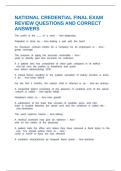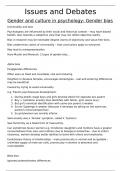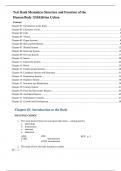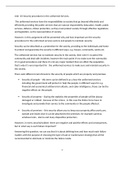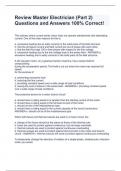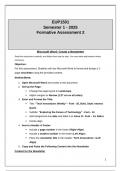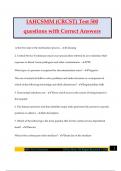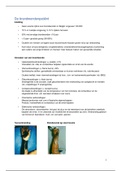Chapter 1 | Convincing documents
What is persuasion?
Persuasion (O’Keefe) Persuasion is a successful intentional effort at influencing
another’s mental state through communication in a circumstance in which the persuade
has some measure of freedom.
The mental state usually equated with attitude A psychological tendency that is
expressed by evaluating a particular entity with some degree of favor of disfavor.
Hereby entity may be an individual or agency, behavior, policy or product.
The evaluative judgement (attitude) is stored in memory along with any other
information about the entity.
Although the definition doesn’t mention behavior, many attempts at persuasion are
aimed at influencing behavior. BUT persuasion proceeds by means of communication:
the transfer of information, which affects people’s mental state. Communication may
lead to a new or different attitude, which in turn may change behavior.
Communication cannot have a direct impact on behavior.
What is the difference between persuasive and informative documents?
Informative documents to provide information (informing)
Instructive documents to help readers perform certain actions (instructing)
Persuasive documents to convince readers of a particular point of view (convincing)
Persuasive documents are designed with the aim of influencing reader’s attitude through
the transfer of information, with the readers having a certain degree of freedom.
Readers of informative documents expect the writer to present all relevant information
honestly and as clearly and efficiently as possible (communication principle)
Readers of persuasive documents appear unconvinced that this has been done since the
writer has an interest in suppressing negative arguments and embellishing positive
arguments. Readers’ distrust of persuasive documents has also led to advertisement
labels as ‘sponsored content’.
What four instruments are available to a government when they want to influence
behavior?
Financial instruments Tax benefits when buying a hybrid car and higher road taxes for
heavier vehicles)
Private law instruments allowing the trade in manure permits
Direct regulation via legislation (= wetgeving)
Social regulation via, for example, public information.
The choice of instrument depends primarily on the properties of the available
instruments but also on the nature of the situation.
,What is the role of ‘enforcement burden’ and ‘personal responsibility’ in the choice
between these measures?
In its comparison of the instruments, it distinguishes two dimensions:
1) Enforcement burden Government has, for example, to employ inspectors
2) Personal responsibility Government appeals to the own responsibility (like wash
your hands during the Corona pandemic)
If the government decides to adopt laws or regulations, these will come with a certain
enforcement burden since the government must be prepared to enforce them.
Personal responsibility and enforcement burden are “communication vessels”. The
more the instruments appeal to citizen’s personal responsibility, the lighter the
government’s enforcement burden. If the instrument allows less personal responsibility,
the enforcement burden increases.
How does urgency of the situation influence the choice between these measures?
The choice for either direct or social regulation depends on the nature of the situation:
Very urgent situations the risks are so high that immediate and effective
action is imperative. Use direct regulation since it is in principle more effective to
enforce the desired behavior.
Less urgent situations The government can choose between several
instruments based on the nature of the situation, with the following 3 dimensions
playing a role:
1) Measurability of the behavior the ease – or difficulty – with which the
government can monitor whether people abide by the rules. The easier the
lower the enforcement burden
2) Structure of the target group Concerns the size and the heterogeneity of
the group who are supposed to change their behavior. Small and easy to
identify light enforcement burden
3) Costs for the target group does the new behavior lead to higher costs for
the target group, to less comfort, to physical or mental problems? The higher
the people in the target group perceive the costs to be, the less they will be
inclined to adopt the desired behavior.
When should communication be considered as a way to influence behavior?
Even if the government opts for direct regulation to prevent undesirable situations,
communication can still play an important role in making it easier to implement and enforce
the rule. (By, for example, explaining the rationale behind the measure)
When the communication document meets the following 2 factors:
1) The scope Mass media
2) The differences in quality between campaigns Campaign put together with a lot
of thought.
What is meant by ‘effect size’?
The difference between two means in terms of the standardized effect size. The
difference between the means divided by the Standard Deviation (Cohen’s D)
, What is the take-home message of the authors about the effect-size of communication
research?
Chapter 2 | Determinants of behavior
What is priming?
Priming activating concepts or stereotypes by confronting people with words
in real life, these stereotypes are evoked by people who belong to the
stereotypical group
Subliminal priming Items are presented such a short time that the subject could not
consciously perceive them and is therefore below the threshold of conscious perception
(the subjects did not know what they saw)
What are the components of the Integrative Model of Behavioral Prediction and how are
they related? {you should be able to draw the model and fill in the boxes}
Direct variables have direct bearing on a person’s behavior
Indirect variables only influence behavior through the effect that they have on the direct
variables
A person’s behavior is primarily decided by three determinants:
- The intention to perform the behavior [aspiration to perform a healthy meal]
- The skills necessary to perform the behavior [sufficient knowledge of recipes and
kitchen experience to prepare such a healthy meal]
- The environmental constraints that may hinder one to perform the behavior [the
availability of fresh and healthy ingredients and the necessary kitchen appliances]
What is persuasion?
Persuasion (O’Keefe) Persuasion is a successful intentional effort at influencing
another’s mental state through communication in a circumstance in which the persuade
has some measure of freedom.
The mental state usually equated with attitude A psychological tendency that is
expressed by evaluating a particular entity with some degree of favor of disfavor.
Hereby entity may be an individual or agency, behavior, policy or product.
The evaluative judgement (attitude) is stored in memory along with any other
information about the entity.
Although the definition doesn’t mention behavior, many attempts at persuasion are
aimed at influencing behavior. BUT persuasion proceeds by means of communication:
the transfer of information, which affects people’s mental state. Communication may
lead to a new or different attitude, which in turn may change behavior.
Communication cannot have a direct impact on behavior.
What is the difference between persuasive and informative documents?
Informative documents to provide information (informing)
Instructive documents to help readers perform certain actions (instructing)
Persuasive documents to convince readers of a particular point of view (convincing)
Persuasive documents are designed with the aim of influencing reader’s attitude through
the transfer of information, with the readers having a certain degree of freedom.
Readers of informative documents expect the writer to present all relevant information
honestly and as clearly and efficiently as possible (communication principle)
Readers of persuasive documents appear unconvinced that this has been done since the
writer has an interest in suppressing negative arguments and embellishing positive
arguments. Readers’ distrust of persuasive documents has also led to advertisement
labels as ‘sponsored content’.
What four instruments are available to a government when they want to influence
behavior?
Financial instruments Tax benefits when buying a hybrid car and higher road taxes for
heavier vehicles)
Private law instruments allowing the trade in manure permits
Direct regulation via legislation (= wetgeving)
Social regulation via, for example, public information.
The choice of instrument depends primarily on the properties of the available
instruments but also on the nature of the situation.
,What is the role of ‘enforcement burden’ and ‘personal responsibility’ in the choice
between these measures?
In its comparison of the instruments, it distinguishes two dimensions:
1) Enforcement burden Government has, for example, to employ inspectors
2) Personal responsibility Government appeals to the own responsibility (like wash
your hands during the Corona pandemic)
If the government decides to adopt laws or regulations, these will come with a certain
enforcement burden since the government must be prepared to enforce them.
Personal responsibility and enforcement burden are “communication vessels”. The
more the instruments appeal to citizen’s personal responsibility, the lighter the
government’s enforcement burden. If the instrument allows less personal responsibility,
the enforcement burden increases.
How does urgency of the situation influence the choice between these measures?
The choice for either direct or social regulation depends on the nature of the situation:
Very urgent situations the risks are so high that immediate and effective
action is imperative. Use direct regulation since it is in principle more effective to
enforce the desired behavior.
Less urgent situations The government can choose between several
instruments based on the nature of the situation, with the following 3 dimensions
playing a role:
1) Measurability of the behavior the ease – or difficulty – with which the
government can monitor whether people abide by the rules. The easier the
lower the enforcement burden
2) Structure of the target group Concerns the size and the heterogeneity of
the group who are supposed to change their behavior. Small and easy to
identify light enforcement burden
3) Costs for the target group does the new behavior lead to higher costs for
the target group, to less comfort, to physical or mental problems? The higher
the people in the target group perceive the costs to be, the less they will be
inclined to adopt the desired behavior.
When should communication be considered as a way to influence behavior?
Even if the government opts for direct regulation to prevent undesirable situations,
communication can still play an important role in making it easier to implement and enforce
the rule. (By, for example, explaining the rationale behind the measure)
When the communication document meets the following 2 factors:
1) The scope Mass media
2) The differences in quality between campaigns Campaign put together with a lot
of thought.
What is meant by ‘effect size’?
The difference between two means in terms of the standardized effect size. The
difference between the means divided by the Standard Deviation (Cohen’s D)
, What is the take-home message of the authors about the effect-size of communication
research?
Chapter 2 | Determinants of behavior
What is priming?
Priming activating concepts or stereotypes by confronting people with words
in real life, these stereotypes are evoked by people who belong to the
stereotypical group
Subliminal priming Items are presented such a short time that the subject could not
consciously perceive them and is therefore below the threshold of conscious perception
(the subjects did not know what they saw)
What are the components of the Integrative Model of Behavioral Prediction and how are
they related? {you should be able to draw the model and fill in the boxes}
Direct variables have direct bearing on a person’s behavior
Indirect variables only influence behavior through the effect that they have on the direct
variables
A person’s behavior is primarily decided by three determinants:
- The intention to perform the behavior [aspiration to perform a healthy meal]
- The skills necessary to perform the behavior [sufficient knowledge of recipes and
kitchen experience to prepare such a healthy meal]
- The environmental constraints that may hinder one to perform the behavior [the
availability of fresh and healthy ingredients and the necessary kitchen appliances]

